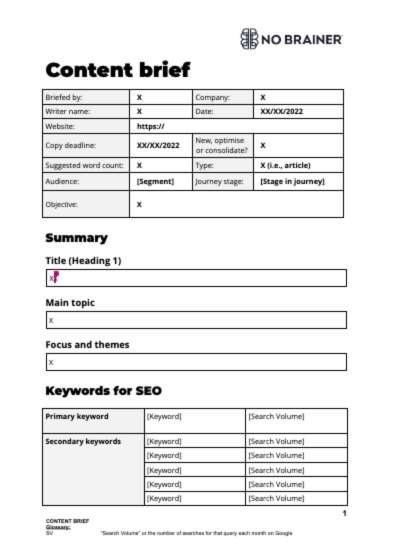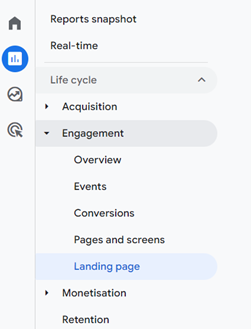Content feeds into every element of marketing and across all channels. It’s the hook that catches people’s attention, the information that answers their questions, contains the solutions to their problems and gives them everything they need in order to make a buying decision.
However, content marketing measurement can also seem a bit overwhelming at times. There are so many metrics and things that could potentially be tracked that working out which ones actually matter to your business isn’t always as straightforward as it should be. However, without effective measurement of performance, you can’t know which parts of your strategy are working well and which need to change, so it’s vital to get this right.
Overview of content metrics to measure performance (and where to find them)
- Overall visibility on search (check out SISTRIX or Share of Voice in your SEO tools)
- Ranking keyword performance has increased (GSC or your SEO tools)
- People are linking to your great content (backlinks via GSC or your SEO tools)
- Referral traffic (GA4)
- Assisted conversions (Google Analytics custom report)
- Increase in brand search query performance (GSC or your SEO tools)
- Increase in engagement and repeat visits
Ultimately, great content can and will impact your bottom line – from enquiries and leads, to good old revenue. Which is why it’s vital to make the very BEST content you can, and that all starts with a good brief.
Here’s our FREE content brief template that you can copy and use for yourself!
Let’s explore further what makes particular content marketing metrics useful, how to best set goals for your content that marry up with measurement and provide some examples of important metrics for specific kinds of content marketing types and objectives.
What makes a content marketing metric useful?
There are multiple different ways to track and measure digital content, but the key to effective reporting is to focus on the metrics that really matter to your business and your goals and objectives.
A useful content marketing metric needs to:
- Be relevant to your wider goals
- Give you actionable insights
- Be straightforward to measure
- Be benchmarked, to show progress
Setting content marketing goals
As part of your content strategy development, it’s important that every content asset and activity undertaken has a purpose that contributes towards your wider marketing goals. If there is no specific outcome that you have determined for a content marketing activity, you shouldn’t be doing it in the first place.
As with most things in marketing, setting the right goals in content marketing comes back to understanding your audience and their customer journey well.
Knowing what your target audience segments need content-wise in order to move down the funnel is the crux of it all, and makes it much more straightforward to allocate KPIs to different activities.
Each piece of content and its individual activation needs to tie back to a specific purpose. There may be secondary benefits too, but there needs to be one that’s a priority in terms of the contribution it makes to wider objectives.
Below, we look at a variety of different objectives and some of the content marketing metrics you might find useful to show how well you’re doing in that area.
Content marketing metrics for brand awareness objectives
Brand awareness is one of the areas that can feel quite difficult to measure. But there are plenty of data points you can bring together, which will give a strong indication of whether brand awareness content activity is doing what it should be.
- On social media, your social shares, impressions and increases in follower counts that correlate with your content activity can all indicate progress on this goal.
- On your website, checking for increases in Google Search Console (GSC) for impressions and clicks that stem from brand-related search queries can also indicate your brand is becoming more well-known.
Content marketing metrics for SEO performance objectives
Content that brings relevant organic search traffic to your website is incredibly valuable and can contribute to your SEO performance over months and years to come.
It could be blog content, optimised service pages, guides, product pages, explainer or how-to videos, tools or calculators or more. While the specific metrics to most effectively measure the SEO performance of different content formats can vary, some of the most common include:
Organic traffic in GA4:
How many users (unique) visit this specific page via search engines, average engagement time and engagement rate. Turning on ‘enhanced measurement’ in your GA4 settings will mean you can access more data, such as how many users have scrolled at least 90% of the page.
Google Search Console:
- Impressions and clicks for the page
- Queries people are using to find your page (are these the keywords you are specifically targeting?)
- Average ranking position improvements.
Backlinks:
Is anyone else linking to your content? Are links from relevant and authoritative sites? All of these help boost your performance!
Content marketing metrics for ecommerce objectives
While content will play a significant role in product sales, it won’t always receive the attribution it deserves for the part it has played in the customer journey.
That being said, there are some metrics that can help to link content to ecommerce transactions and revenue, which include:
- Setting up a landing page report in GA4, which can show purchases resulting from a specific page containing your content.
- Viewing other GA4 conversion metrics that you know contribute to revenue over a longer timeframe, such as newsletter sign ups, whitepapers downloaded, enquiry forms filled in.
Content marketing metrics for lead generation objectives
If you’re a service provider, linking content performance to leads and enquiries that have been generated is essential, so you can see how successful your current and past activity is for future strategy insight, as well as being able to calculate a tangible return from content.
If you’re using email as part of your content marketing strategy, incorporating measurement from these campaigns and ensuring the chain of information doesn’t end when someone clicks from an email to your website is really important.
Tracking what email-driven users do once they reach your website will give you great insight into how successful this particular channel is. Use UTM parameters on every email link to tie site traffic and conversions back to specific emails and stories or CTAs within them.
Tracking various enquiry forms and CTAs related to specific pieces of content can also be very useful. Many websites just use the same form site-wide for simplicity. But even if they look the same to the end user, making sure that they are tracked individually behind the scenes in GA4 can be another helpful metric to tie user conversions back to your content marketing activity directly.
Content reporting
What will have become clear throughout this article is that there are a wide range of different metrics to measure content marketing performance, which are influenced by the wider objectives and the types of content activity you are using. This can feel very difficult to keep track of, especially as the data can come from several different sources.
One solution is to create a custom dashboard in a tool such as Google’s Looker Studio (formerly Data Studio). There is the capability to pull data from several sources into the same report, although third-party (non-Google) tools will need API access to integrate and this can get complicated. Using a paid tool, such as Supermetrics, can usually do a lot of the legwork for you, but there will always be some setup time and effort needed.
Effective reporting on content marketing can make a huge difference to how content is viewed by your organisation and stakeholders, along with future marketing budgets and priorities, so getting this right can be key and certainly worth the resource involved.
If you want specialist assistance with your content marketing strategy, we’d love to hear from you. Get in touch using the form below.











